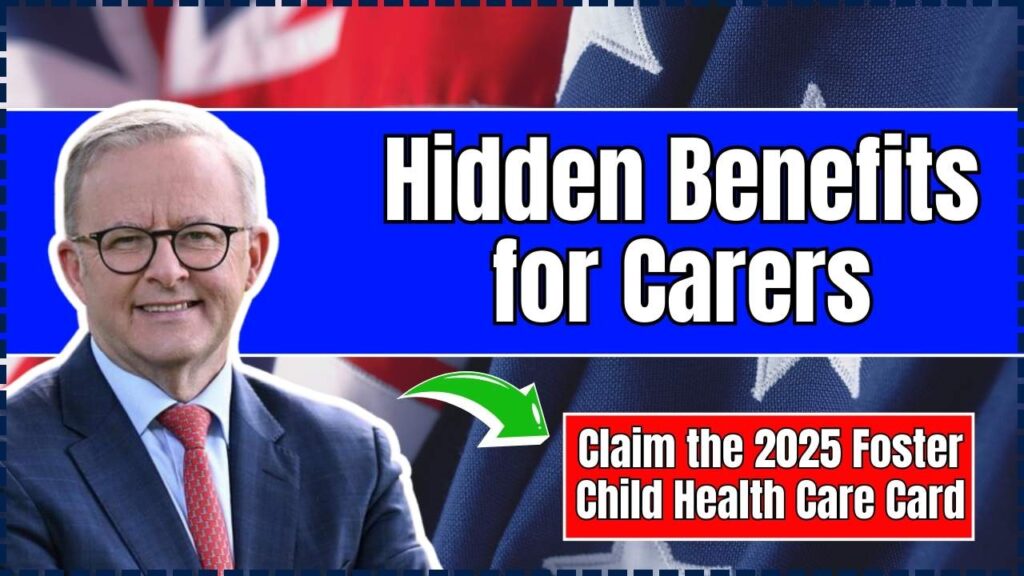Hidden Benefits for Carers: If you’re a foster carer in Australia, you might be eligible for a little-known but incredibly helpful government benefit: the Foster Child Health Care Card. In 2025, this card continues to offer significant advantages to those caring for children who aren’t their biological or adopted children. But many carers don’t even know they can claim it—or how much it actually helps.

This comprehensive guide explains everything you need to know about the 2025 Foster Child Health Care Card. From its key benefits and how to apply, to who qualifies and what to avoid, we’ve made it clear, practical, and easy to follow. Whether you’re new to fostering or have years of experience, these insights will help you take full advantage of this support.
Hidden Benefits for Carers
| Feature | 2025 Details |
|---|---|
| Eligibility | Foster carers of non-biological children (no income/assets test) |
| Card Validity | 12 months (automatically renewable if eligible) |
| Major Benefits | Cheaper medicines, bulk-billed GP visits, hospital discounts |
| Additional Perks | State-based discounts on utilities, education, and transport |
| Application Options | Online via myGov, phone, in-person |
| Official Website | Services Australia |
The 2025 Foster Child Health Care Card is more than a government formality—it’s a powerful support tool for carers giving their time, energy, and love to children in need. If you’re stepping in to care for a foster child, this card helps make sure the child receives the healthcare and support they need without overwhelming you financially.
The application is simple, the benefits are real, and the impact can be life-changing. Don’t let this opportunity pass by. Apply today and help secure better access, stability, and wellbeing for the children you care for.
What Is the Foster Child Health Care Card?
The Foster Child Health Care Card is a concession card issued by the Australian Government to eligible foster carers. Administered through Services Australia, the card provides financial relief by subsidising medical and associated expenses for children in care.
This benefit was created to ensure that children placed in out-of-home care receive affordable and timely access to healthcare services. Unlike many Centrelink benefits, the Foster Child Health Care Card is not means-tested, making it more inclusive and accessible.
Foster carers provide crucial stability and love for vulnerable children, and this card is designed to ease the financial burden that can come with providing that care. From medications to school-related discounts, the card ensures carers can support the child’s physical and emotional wellbeing without financial strain.
Why It Matters More Than Ever in 2025
With continued rises in cost-of-living expenses and increasing demands on health services, 2025 is an important year to fully utilise all available government supports. Even though the Foster Child Health Care Card has existed for years, its awareness and uptake remain surprisingly low. Yet the value it offers is clear:
- Monthly medical costs can be slashed by over 50% with the PBS subsidy.
- Out-of-pocket expenses for GP visits can be entirely eliminated.
- Utility and transport savings across states can total hundreds annually.
Let’s say a foster carer manages medication for asthma, antibiotics, and therapy costs each month. Without the card, they might pay $300 or more. With the card, this could drop to under $60 depending on prescriptions and discounts.
Some public schools even waive or reduce extracurricular fees for children holding this card, easing further pressure on the household budget.
Who Can Apply for the Card in 2025?
Eligibility Checklist
To qualify for the Foster Child Health Care Card in 2025, you must:
- Be caring for a child who is not your biological or adopted child.
- Be in a formal or informal foster care arrangement, including kinship care or emergency placement.
- Ensure the child lives with you most of the time.
- Be an Australian resident or hold an eligible visa.
- Be registered with Centrelink, as the benefit is processed through them.
Foster carers, kinship carers, and even informal carers (e.g. grandparents, close family friends) may qualify if the arrangement is recognised.
There is no income or asset test required, and eligibility is based on the relationship and caregiving role, not your financial situation.
What the Card Pays For: Core and Extra Benefits
The Foster Child Health Care Card offers a broad range of benefits that go beyond just GP visits. Here’s a breakdown:
Health and Medical Benefits
- Discounted Prescription Medicines: Reduced costs under the Pharmaceutical Benefits Scheme (PBS).
- Bulk-Billed GP Services: Doctors are encouraged to bulk bill children with the card, eliminating consultation fees.
- Hospital and Diagnostic Discounts: Lower out-of-pocket costs for some diagnostic services or hospital visits.
Other Financial Perks (Based on State/Territory)
- Public Transport Concessions: Available in most states including NSW, VIC, and QLD.
- School Expenses: Help with uniforms, booklists, excursions, or technology subsidies.
- Utility Rebates: Some states offer discounts on water, gas, and electricity.
- Dental and Optical Services: In select regions, public dental and vision check-ups may also be subsidised.
State-specific perks vary, so check with your state or territory government or foster care association for more information.
Hidden Benefits for Carers Apply Instructions for 2025
- Gather Your Supporting Documents: You’ll need:
- Proof of identity for both the child and yourself (e.g. Medicare card, birth certificate).
- Documentation of the care arrangement (e.g. a letter from your child protection agency, court orders, or placement confirmation).
- Centrelink customer reference number (CRN), if you already have one.
- Choose Your Preferred Application Method:
- A. Online:
- Visit myGov and link your Centrelink account.
- Navigate to “Make a Claim” and select “Concession Cards.”
- Upload documents and follow the on-screen instructions.
- A. Phone:
- Call Centrelink on 136 150 (Families line).
- A representative can guide you through your claim or set up an appointment.
- C. In-Person: Visit your nearest Centrelink service centre with all documents.
- A. Online:
- What Happens After You Apply?:
- You will receive a receipt of submission and estimated processing timeframe.
- Most cards are approved within 2 to 4 weeks.
- Track your application through your myGov account or the Express Plus Centrelink app.
Validity Period and Renewal Process
- The card remains valid for 12 months from the date of issue.
- It is automatically renewed if the care arrangement is still active.
- Keep your Centrelink details updated, including your address, care status, and contact info.
Tips to Ensure Renewal:
- Respond to any Centrelink letters or updates promptly.
- Update your care arrangement if a child enters or exits your care.
Common Pitfalls to Avoid When Claiming the Card
Mistake #1: Missing or Incomplete Documents
Make sure your documents are readable and up to date.
Mistake #2: Delay in Reporting Care Changes
Not updating Centrelink when a child leaves your care can result in issues or overpayments.
Mistake #3: Not Applying Due to Confusion
Many carers think they’re ineligible if they’re informal carers. Always check with Centrelink if you’re unsure.
Mistake #4: Assuming Benefits Are Automatic
You must apply even if you receive other Centrelink payments. The card is not automatically issued.
FAQs On Hidden Benefits for Carers
Can I use this card for my own child?
No, this card is only valid for children in your care who are not biologically or legally your own.
Will this affect other Centrelink payments?
No. The card is a standalone benefit and will not reduce your Family Tax Benefit or Carer Allowance.
Can I get a card for more than one child?
Yes. A separate card is issued for each eligible child in your care.
What if I share care with another person?
Only the primary carer can apply. Speak with Centrelink if there’s a shared care arrangement.
Do I need to reapply every year?
Not usually. The card renews automatically if eligibility continues and Centrelink has up-to-date information.






